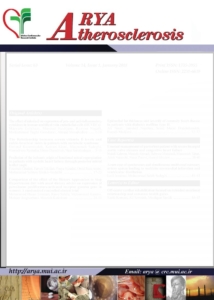Evaluation of heart rate reserve and high-sensitivity C-reactive protein in individuals with and without metabolic syndrome in Isfahan, Iran
Authors
Affiliations
1Resident, Isfahan Cardiovascular Research Center, Isfahan Cardiovascular Research Institute, Isfahan University of Medical Sciences, Isfahan, Iran
Abstract
Background: Lack of heart rate increase proportionate to exercise causes poor prognosis. Moreover, inflammatory factors such as C-reactive protein (CRP) are associated with atherosclerosis. The current study compared these two indices in individuals with and without metabolic syndrome in Isfahan, Iran.
Methods: This study was performed on 203 people without and 123 patients with metabolic syndrome who were randomly selected from the participants of the Isfahan Cohort Study. The demographic data, waist circumference, blood pressure, height, and weight of the participants were recorded. Moreover, serum tr`viglyceride (TG), fasting blood sugar (FBS), total cholesterol, high density lipoprotein (HDL), low density lipoprotein (LDL), and high-sensitivity CRP (hs-CRP) levels were measured. Exercise test was carried out according to the Bruce standard protocol and heart rate reserve (HRR) was determined and recorded. The age-adjusted data was analyzed using generalized linear regression and student’s t-test in SPSS(15).
Results: The mean ages of participants without and with metabolic syndrome were 54.16 ± 8.61 and 54.29 ± 7.6 years, respectively. The corresponding values for mean LDL levels were 116.17 ± 24.04 and 120.12 ± 29.55 mg/dl. TG levels were 140.38 ± 61.65 and 259.99 ± 184.49 mg/dl for subjects without and with the metabolic syndrome, respectively. The mean FBS levels were 81.81 ± 9.90 mg/dl in the participants without the syndrome and 107.13 ± 48.46 mg/dl in those with metabolic syndrome. The mean systolic blood pressure was 116.06 ± 13.69 mmHg in persons without metabolic syndrome and 130.73 ± 15.15 mmHg in patients with the syndrome. The values for mean diastolic levels in the two groups were 76.52 ± 6.69 and 82.84 ± 8.7 mmHg, respectively. While the two groups were not significantly different in terms of HRR (P = 0.27), hs-CRP levels in the metabolic syndrome group was significantly higher than the other group (P = 0.02).
Conclusion: We failed to establish a relationship between HRR and the metabolic syndrome. However, the observed relationship between metabolic syndrome and hs-CRP level, which is an inflammatory factor, indicates elevated levels of hs-CRP in patients with metabolic syndrome.
Keywords: Exercise Test; Heart Rate Reserve; High-Sensitivity C-Reactive Protein; Metabolic Syndrome
How to Cite
. Summer 2012;8(2):70-5. PMID: 23056106.

